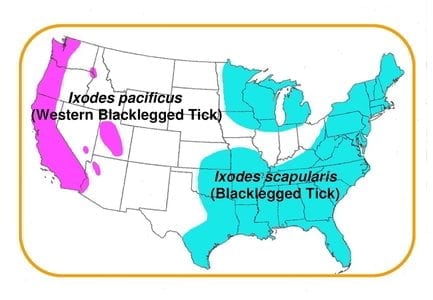This site uses the term “Co-infection” to specifically refer to other non-Lyme illnesses that are transmitted by black-legged ticks. Thus, while every co-infection is also a tick-borne disease, not all tick-borne diseases are co-infections.

Formerly known as human granulocytic ehrlichiosis, anaplasmosis (formerly known as human granulocytic anaplasmosis or HGA) is caused by Anaplasma phagacytophilum. Infection is potentially serious with a mortality rate of < 1%. Death, though quite uncommon predominately occurs in the very young and very old. Most cases in the United States occur in the Midwest and Northeast.
Symptoms of anaplasmosis (and ehrlichiosis) include:
- Fever
- Malaise
- Chills
- Headaches
- Severe muscle aches
- Nausea
- Abdominal pain
- Cough
- Confusion
More severe illness may result if co-infected with Lyme disease.
Lab testing: serology, PCR and microscopic examination of blood specimen
Treatment: doxycycline – should begin when the illness is first suspected.
Malaria-like illness caused by a parasite, Babesia microti, B. duncani, B. divergens and others. Babesiosis is a potentially serious infection and can cause death in those who are immunocompromised. Incubation can last weeks to months.
Symptoms include:
- Fever
- Chills
- Fatigue
- Headache
- Muscle pain
- Sweats
- Anemia
May be more severe in patients with co-existing Lyme disease.
Lab testing:
Direct = blood smear, serology, PCR
Indirect = Results consistent with hemolytic anemia, Eosinophilia
Treatment: often a combination of atovaquone with azithromycin or clindamycin and oral quinine
There have been 6 cases of Borrelia mayonii identified to-date, it is too early to draw conclusions about differences in its symptom pattern compared to Lyme disease.
A recently recognized pathogen in the relapsing fever group of Borrelia, this bacterium invades numerous tissues. This bacteria causes a illness similar to Lyme though it is not closely related to the bacteria that causes Lyme disease.
Symptoms include:
- Fever
- Headaches
- Muscle aches
- Chills
Lab testing: No diagnostic tests are available at this time
Treatment: doxycycline
HME is a potentially serious co-infection caused by Ehrlichia chaffeensis when transmitted by the Western blacklegged tick. HME has a 2-3% mortality rate. Most cases are located in SE and south-central states.
Incubation lasts from 1-2 weeks and symptoms include:
- Chills
- Fever
- Headache
- Muscle aches
- Nausea
66% of kids and 30% of adults develop a fine petechial rash
Lab testing: blood smears to look for bacteria, serology and PCR
Treatment: doxycycline – should begin when the illness is first suspected.
Cases to-date limited to the Upper Midwest. The disease is very similar to anaplasmosis, please refer to that section.
Typically caused by an Ixodes scapularis bite, can also be transmitted by other Ixodes species.
Symptoms begin 7-14 days after a bite and include:
- Headache
- Fever
- Nausea
- Vomiting
- Stiff neck
- Sleepiness
More serious symptoms include confusion, tremors, seizures, paralysis and even coma. Death occurs in 10 to 15% of those infected and 50% of survivors have permanent neurologic issues.
Lab testing: very limited availability, typically sent to CDC
Supportive treatment only; no specific treatment is available.
Caused by several Bartonella species which can be transmitted by flea or louse bite, cat scratch and possibly via ticks.
In suspected tick-borne cases, symptoms included:
- Visual problems
- Headaches
- Lymph node enlargement
- Significant neurologic deficits
- New onset of a seizure disorder
Lab testing: Diagnosis is based on acute and convalescent antibody titers (IFA) and/or positive PCR analysis.
Treatment: may be combination of macrolides (Biaxin, azithromax), tetracyclines, rifamycin (also possible Bactrim or fluoroquinolones)
